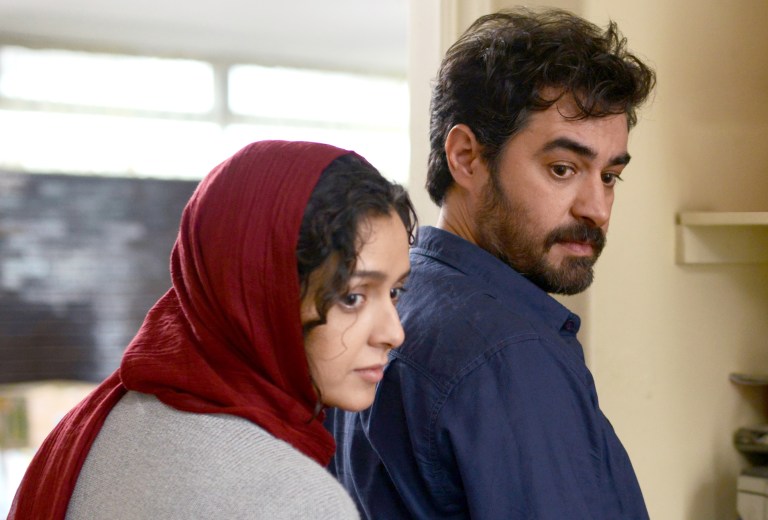In an early scene in Asghar Farhadi’s “The Salesman,” Emad, a high school English teacher, lectures his students on Gholam-Hossein Sa’edi’s play “The Cow.” Sa’edi’s work concerns a man who, after losing his prized cow, suffers a nervous breakdown and begins to act like the animal. One student asks if the play is based on a true story. In response, Emad notes that while the play contains fantastical elements, “in Sa’edi’s writing, the atmosphere and characters are realistic, very close to reality.”
The milieu that Farhadi creates in “The Salesman” is initially very close to reality, but like Sa’edi, he soon begins to combine the quotidian with the extraordinary, to varying degrees of success.
When the film opens, Emad and his wife Rana are looking for a new apartment after their old building was destroyed. Both are also acting in an amateur production of Arthur Miller’s “Death of a Salesman,” playing Willy and Linda Loman, respectively. And fortuitously for them, Babak, a landlord who plays Charley in the production, has a tenant that recently vacated one of his apartments. And he is willing to rent it to them at a price they can afford.
But after they move into their new apartment, they find that the previous tenant moved out under unusual circumstances. Neighbors tell them that she had a checkered past. And one night, after a performance, Rana is mysteriously attacked in the shower, her face bludgeoned.
The enigmatic previous owner of Emad’s and Rana’s apartment haunts the entirety of “The Salesman.” On a figurative level, her dark existence casts a long shadow over the lives of Emad and Rana, tainting their once-happy existence. On a literal level, her abandoned possessions clog Emad’s and Rana’s current home.
But Farhadi’s work is more ambitious than the average ghost story. It is not merely Emad’s and Rana’s apartment that hostilely suffocates them. The setting of contemporary Tehran is as crucial to “The Salesman” as the Overlook Hotel is to “The Shining.” Indeed, “The Salesman” could not function without it. In most haunted house films, the characters try to find and exorcise the poltergeists plaguing their lives. In “The Salesman,” Emad and Rana cover up their demons so that they can remain respectable by Iran’s stringent societal standards.
Emad and Rana, their positions in society already threatened by the sudden loss of their apartment and their precarious financial situation, are further undercut by the assault in the shower. Emad can’t focus on his work. Rana refuses to leave the apartment, and will not enter the bathroom. They both find that the security that once surrounded them has ceased to exist.
When the film began, the relationship between Emad and Rana seemed quite conventional. But under pressure, their bond starts to fracture. They lose their connection with each other, as they both take shockingly different responses to the assault. Rana tries to forget about it, but can’t. Emad refuses to report the crime to the police for fear of losing face, but remains intent on making sure the perpetrator pays.
Unfortunately, Farhadi sometimes has trouble balancing the realistic and the melodramatic. Certain sensational plot developments eventually overwhelm the subtle, quiet tension that Farhadi has been developing between Emad and Rana. Something important is lost as the film approaches its fevered conclusion. The references to “Death of Salesman” become less and less frequent, while Emad becomes more and more vengeful. The film remains interesting. But as the work shifts from a contemplative domestic drama to a pedestrian tale of vengeance, it loses some of its resonance and enigmatic poignancy.
Still, I would strongly recommend “The Salesman.” It should appeal to any viewer interested in domestic dramas, art-house cinema or foreign films. It’s Iran’s nominee for the Best Foreign Language Film Oscar, and rightly so. “The Salesman” is not only an excellent film, but a consummately Iranian one. There is not a single decision Emad and Rana make throughout the film that is not influenced by Iranian laws and social norms.
Yet, at the same time, “The Salesman” seems global. Miller’s “Death of a Salesman” is considered by many to be the ultimate statement on the American Dream in the 20th century. And yet, Farhadi finds resonances between Miller’s work about the struggle of social mobility in 20th-century America and contemporary Iranian society.
Just as he mixes the normal with the bizarre, Farhadi combines the local with the global – creating a small, unassuming film that is somehow weighty, thought-provoking and compelling.
Contact Amir Abou-Jaoude at amir2 ‘at’ stanford.edu.
